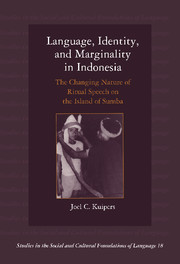 Language, Identity, and Marginality in Indonesia
Language, Identity, and Marginality in Indonesia Book contents
- Frontmatter
- Contents
- List of plates
- List of figures and tables
- Preface
- Acknowledgements
- Notes on orthography
- 1 Introduction
- 2 Place, identity, and the shifting forms of cultivated speech: a geography of marginality
- 3 Towering in rage and cowering in fear: emotion, self, and verbal expression in Sumba
- 4 Changing forms of political expression: the role of ideologies of audience completeness
- 5 Ideologies of personal naming and language shift
- 6 From miracles to classrooms: changing forms of erasure in the learning of ritual speech
- 7 Conclusions
- Notes
- Appendix
- References
- Index
- STUDIES IN THE SOCIAL AND CULTURAL FOUNDATIONS OF LANGUAGE
3 - Towering in rage and cowering in fear: emotion, self, and verbal expression in Sumba
Published online by Cambridge University Press: 05 July 2011
- Frontmatter
- Contents
- List of plates
- List of figures and tables
- Preface
- Acknowledgements
- Notes on orthography
- 1 Introduction
- 2 Place, identity, and the shifting forms of cultivated speech: a geography of marginality
- 3 Towering in rage and cowering in fear: emotion, self, and verbal expression in Sumba
- 4 Changing forms of political expression: the role of ideologies of audience completeness
- 5 Ideologies of personal naming and language shift
- 6 From miracles to classrooms: changing forms of erasure in the learning of ritual speech
- 7 Conclusions
- Notes
- Appendix
- References
- Index
- STUDIES IN THE SOCIAL AND CULTURAL FOUNDATIONS OF LANGUAGE
Summary
Scholarly literature on language “shift” and language “death” often makes these changes appear to be impersonal, structural processes. Of course, speakers are occasionally depicted as sad and angry or dismayed – retrospectively – about the loss of their language; but discussions about the role of emotion in the creation of the conditions of shift themselves are not so easily found. Language shift is not only a structural and pragmatic process, but it is one that is mediated by emotional attitudes and assumptions about the structure and use of language in a particular context. Emotions do not only enter in after the fact, but are part and parcel of the process of shift itself. As Kulick observed in Gapun, New Guinea, women's angry speeches (kroses) in the native language and men's more polite speeches in Tok Pisin were in effect competing ways of representing relations to the outside world: they are choosing the less “angry” and (for them) feminine way (1992a: 294). Similarly, for Mbora Kenda, converting to Christianity – and thus abandoning most forms of ritual speech – was a way of choosing “cunning” over “anger.”
But if emotions have played little role in the study of linguistic change, linguistics has also had a relatively small part in the study of emotional change. When the verbal aspects of emotion are given scholarly recognition, the focus is usually on explicit emotion terms and “hypercognized” (i.e. self-conscious and culturally elaborated) categories of emotional experience such as “shame” and “honor” (Abu-Lughod 1986), or “anger” (Rosaldo 1980; Levy 1984).
- Type
- Chapter
- Information
- Language, Identity, and Marginality in IndonesiaThe Changing Nature of Ritual Speech on the Island of Sumba, pp. 42 - 66Publisher: Cambridge University PressPrint publication year: 1998
- 2
- Cited by
